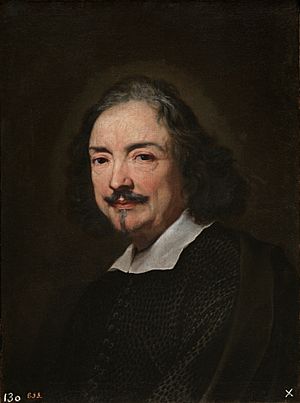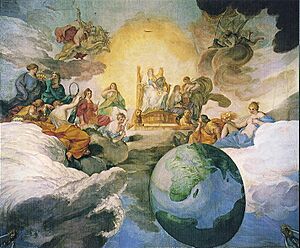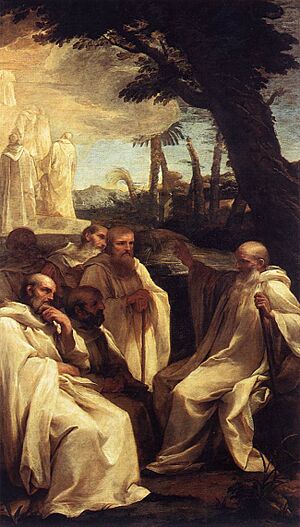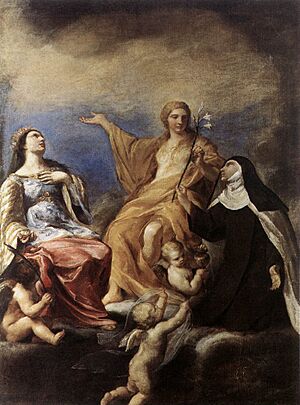Andrea Sacchi facts for kids
Quick facts for kids
Andrea Sacchi
|
|
|---|---|

Portrait by Maratta.
|
|
| Born | 30 November 1599 |
| Died | 21 June 1661 (aged 61) |
| Nationality | Italian |
| Known for | Painting |
| Movement | Baroque |
| Patron(s) | Francesco Maria del Monte |
Andrea Sacchi (born November 30, 1599 – died June 21, 1661) was a famous Italian painter. He worked in Rome during the Baroque period, which was a time known for dramatic and grand art. Sacchi was known for his "Classicism," meaning his art was clear, balanced, and inspired by ancient Greek and Roman styles. Other artists who shared his style included painters like Nicolas Poussin and sculptors like Alessandro Algardi.
Contents
Early Life and Training
Andrea Sacchi was born in Rome. His father, Benedetto, was also a painter, but not very well known. When Andrea was young, his father saw how talented he was. So, he sent Andrea to study with a better master, Cavalier d'Arpino. Andrea was a very focused student and learned quickly.
Later, Sacchi joined the workshop of Francesco Albani. He spent most of his life in Rome, where he eventually passed away. A powerful church leader, Cardinal Antonio Barberini, helped Sacchi a lot in his early career. The Cardinal asked him to create art for a church in Rome and for the grand Palazzo Barberini.
Sacchi's Painting Style
Andrea Sacchi was a friendly rival of another famous painter, Pietro da Cortona. Sacchi carefully studied the paintings of Raphael, a master from an earlier time. You can see Raphael's influence in many of Sacchi's works, especially in how he used only a few figures and showed their feelings.
Sacchi is also thought to have traveled to Venice and Parma. There, he studied the works of Correggio, another important Italian artist. Two of Sacchi's most important paintings are large altarpieces. These are now displayed in the Pinacoteca Vaticana, which is a famous art gallery in the Vatican.
Important Works of Art
The Allegory of Divine Wisdom
This amazing fresco (a painting done on wet plaster) by Sacchi is in the Palazzo Barberini in Rome. It is considered his most important work. The painting, finished between 1629 and 1633, shows "Divine Wisdom." This artwork was inspired by Raphael's "Parnassus," which is in the Raphael's Rooms at the Vatican Palace.
The Miracle of St Gregory the Great
This painting is also known as St Gregory and the Miracle of the Corporal. Sacchi finished it between 1625 and 1657. Today, you can see it in the Pinacoteca Vaticana.
The painting tells a story about Pope Gregory I. An empress named Constantia wanted to have relics (special objects linked to saints) of Saints Peter and Paul. But the Pope did not want to disturb the saints' remains. So, he sent her a piece of linen that had been wrapped around the body of Saint John the Evangelist. Constantia thought this gift was not good enough.
To show the power of relics, Pope Gregory placed the cloth on an altar. After praying, he cut it with a knife, and blood flowed from it as if it were a living body! In 1771, a copy of this painting was made using mosaic tiles for St. Peter's Basilica. This painting showed how important relics were for miracles and how the Pope was the final judge of holy things.
The Vision of St. Romuald
This painting was finished in 1631 and is also in the Pinacoteca Vaticana. It shows a moment from the life of Saint Romuald, an early Benedictine monk. He had a dream where members of his religious group, wearing white robes, went up to heaven. You can see this in the background of the painting. The calm and serious look of the monks, who seem to be discussing deep ideas, is a common feature of Sacchi's style.
Other Famous Works
Some other important examples of Sacchi's art include:
- The Death of St. Anne, found in San Carlo ai Catinari in Rome.
- St. Andrew, located in the Quirinal Palace.
- St. Joseph, at Caponile Case.
- The Three Marys (painted in 1634), which is at the Palazzo Barberini in Rome.
- The Birth of St. John the Baptist and a Portrait of Francesco Albani are among other interesting works at the Prado Museum in Madrid.
- Sacchi also created altarpieces for churches in Perugia, Foligno, and Camerino.
See also
 In Spanish: Andrea Sacchi para niños
In Spanish: Andrea Sacchi para niños




